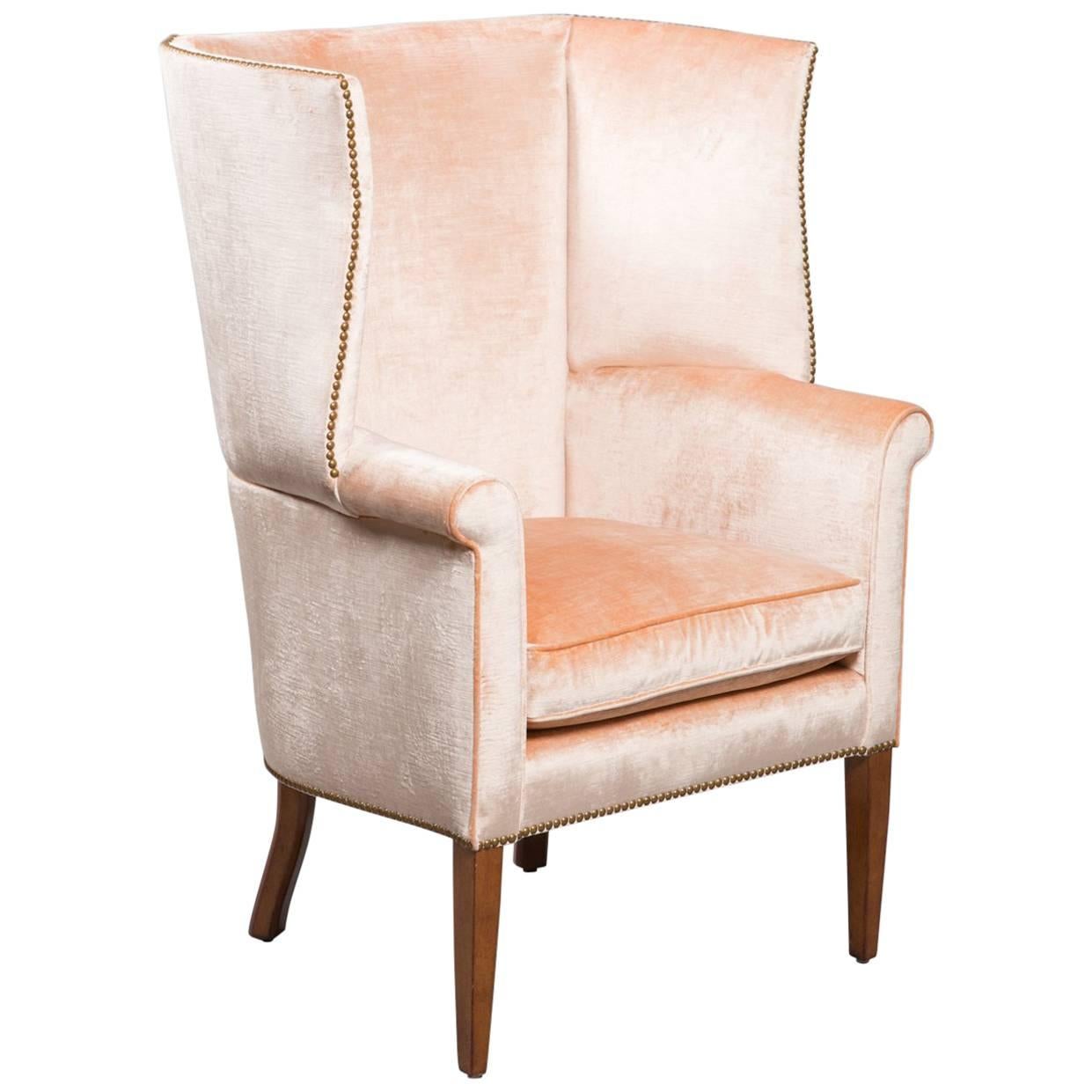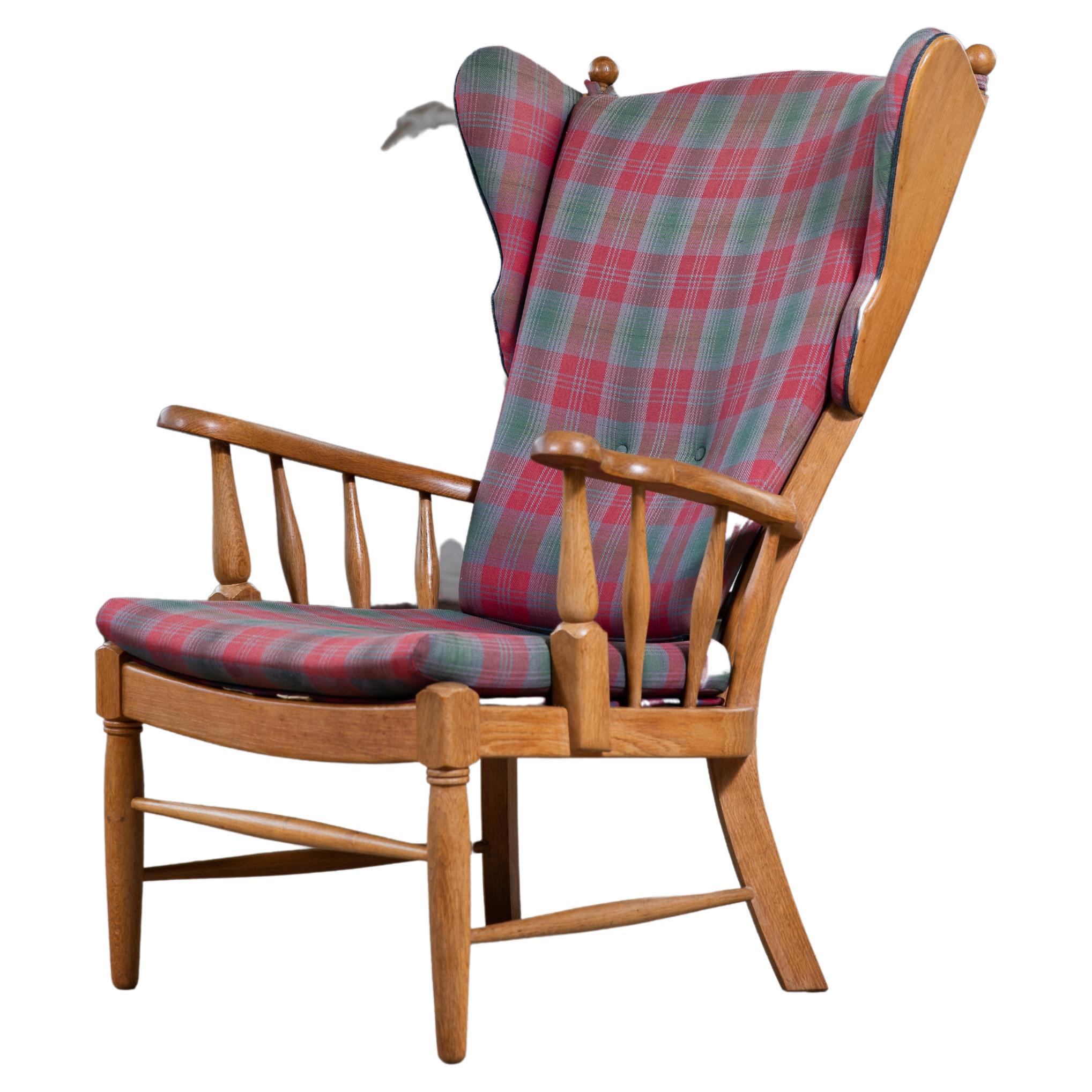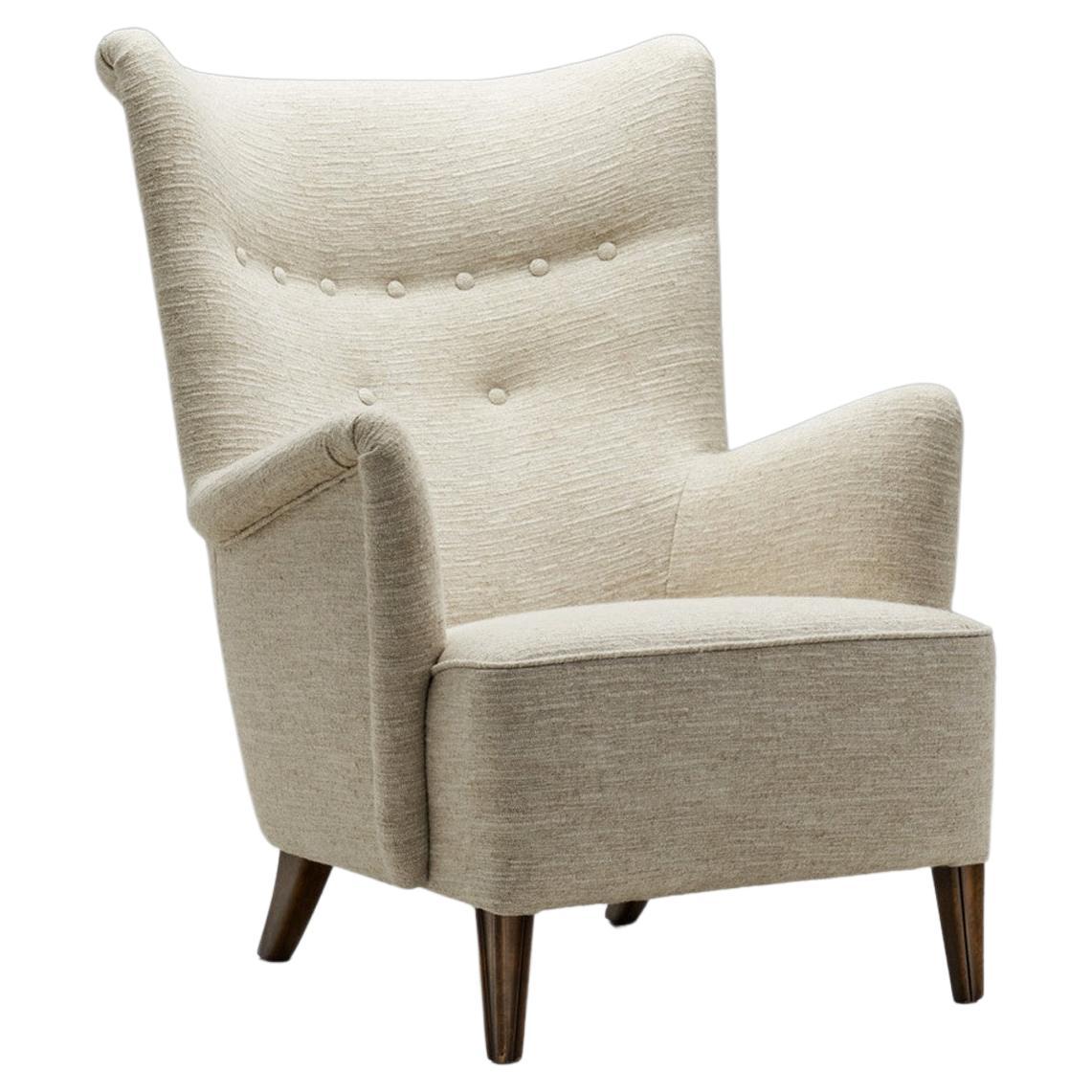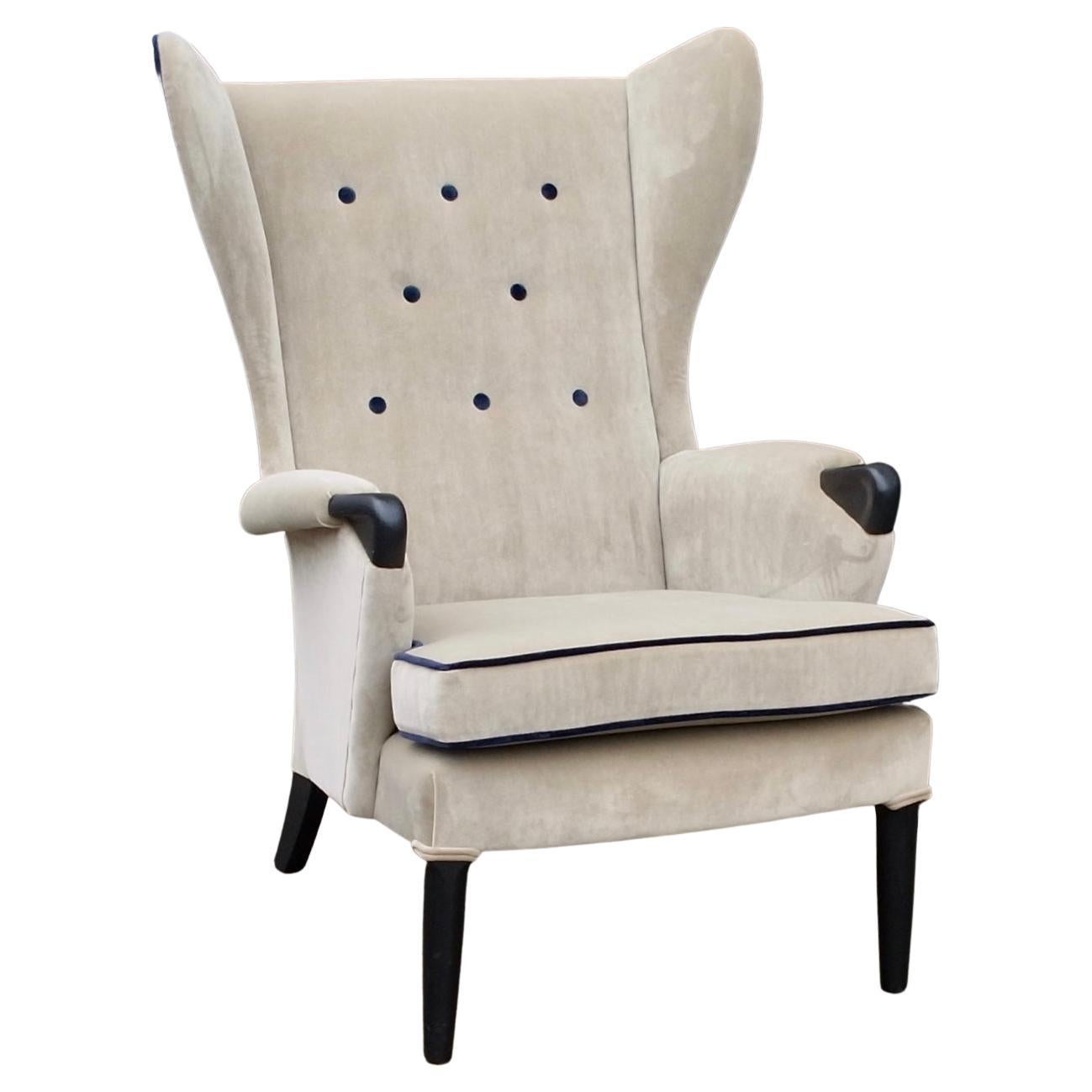Items Similar to Karl Nothhelfer very rare SET of 2 Wingback Armchairs & Sofa 1950s solid Cherry
Want more images or videos?
Request additional images or videos from the seller
1 of 20
Karl Nothhelfer very rare SET of 2 Wingback Armchairs & Sofa 1950s solid Cherry
About the Item
just beautiful
SET of Sofa & 2 Wingback Armchairs
by Prof. Karl Nothelfer - Designed in 1957
maker: Schörle & Gölz in Stuttgart - Bad Cannstatt
solid Cherry Wood
new upholstery and fabrics in 1998 according to last owner ( since then just in use for 2 years so upholstery is perfect ! )
Seatrests can be removed - and fixed by clips on belts
- high class -
measurements:
easy chair is 70cm wide ~ sofa is 178cm wide
both: seating height 40cm ~ seating depth: 57cm
condition - all firm and in very good condition - no damages
furniture have fully been accurately cleaned ::
- 3 steps: A: air pistol - B: industrial hoover - C: latest Kärcher "wash&hoover" technology
- woods have been polished several times
note: please ask for shipping quote by sending us your postcode/destination
Prof. Karl Nothelfer
* 14 June 1900 ~~ + 20 May 1980
Since the beginning of the 15th century, the Nothelfer family of carpenters has been continuously resident in the former
town of Überlingen without interruption. Every carpenter at that time mastered
all the possibilities of woodworking: so did the Nothelfer. They could carpenter,
even carve altars and figures, and set them in gold, silver and paint.
(churches in Owingen and Hödingen]. Some family members lived and worked
and worked in Hedingen or Hödingen,like today the jubilarian Karl Nothelfer (this in 1975).
His father, Karl Anton Nothelfer, as the eldest of seven siblings, was able to take over his father's carpentry business in Überlingen.
Karl Anton Nothelfer, the eldest of seven siblings, was unable to take over his father's carpentry business in Überlingen.
He instead moved to the industrial town of Singen with his young wife Rosalie, née Hanner, from the
from Hohenzollern in 1896 and moved to the former Poststraße and founded his own carpenter's workshop.
He had a highsense of quality and form and was already a member of the German Werkbund before 1914.
Karl Nothelfer and his three siblings grew up in such air.
After attending school and the secondary school in Singen, the young Karl learned the carpenter's trade in his father's workshop then moved on to the Badische Landes-Kunstschule in Karlsruhe,
where he studied architecture. At that time the well-known furniture professor also worked there
Fritz Spannagel, born in Freiburg in 1891, who settled in 1938 at Ittendorf Castle near Meers-
burg (died 1957). In 1928, the gifted young architect received a teaching assignment at the
at the Karlsruhe School of Art, but followed his teacher Spannagel to Berlin in the same year.
Berlin. Here he worked from 1928-1945 as a teacher - appointed professor in 1931 - at the
Berlin Tischler-Schule, the later Bauschule für Raumgestaltung.
The furniture he created in Berlin became internationally known through many exhibitions and lectures.
nationally known and influential. His furniture creations ushered in a new era in German and
a new era in German and European furniture design. At the world exhibition in Paris
1937 Prof. Nothelfer was awarded the Golden Medal for his work in the furniture sector.
for his work in the furniture sector. A first summary and balance of his work on furniture is given in his standard work
1942 published standard work "Das Sitzmöbel", the first compendium of its kind in the world.
world. In 1950 he published his second work "Furniture". Both books and a
series of brochures were published by Verlag Otto Maier, Ravensburg.
Karl Nothelfer continued to work intensively on the design of seating furniture in the years after 1945.
In 1950 he succeeded in the important invention of the two-legged skid-base chair, which has been
orthopedically - anatomically tested thousands of times - has become accepted all over the world today.
Even the most distinguished American furniture companies such as Miller or Knoll-International
use the skid as the main theme for desks and chairs. At the same time, N. had a groundbreaking
in the redesign of German school furniture and seating for industry.
industry. He succeeded in adapting his furniture forms, which originated in wood and handicraft, to the modern technical
modern technical possibilities of the industry. He thus became the great refor-
of schoolroom furnishings. The architect Nothelfer thinks about himself,
that he made his main contribution in the field of seating furniture, although this was not
was not really his profession.
After the war, Prof. Nothelfer, like so many others, had to start all over again. He settled
settled in his home town of Lake Constance in Hödingen in 1945 as a freelance architect and was
and was involved in all areas of construction in the years after the war. As early as 1935, he had given many
the example of American prefabricated buildings and recommended serial house
and recommended it at a time when no one in Germany was even thinking about mass production. Now he developed
he developed several types of mass-produced houses, which were manufactured in Baiersbronn.
of which more than 800 houses were built in France alone (types Paris, Provence, Normandie).
were built. At that time [1946], as part of the reparations in Strasbourg, there was an exhibition of houses with Swedish, Danish, and French designs.
with Swedish, Danish, Finnish, English and German houses, where the French occupation
for which 6 different types were sent from the French occupation zone, the
Nothelfer's house type was considered the top of this exhibition.
Karl Nothelfer was also involved in the development of chipboard. In 1946, together with others in Munich, he founded the first
magazine "Bauen und Wohnen" ("Building and Living") after the war and remained its co-editor for many years.
co-editor of this magazine for many years. By presenting his own work, he has here
interpreted what the essence of the magazine wanted to be: Building, in order to live in it, in order to live as a human being and humanly in the built. Karl Nothelfer planned his houses
furniture ground plan, from the need for living. In 1948 he was appointed honorary senator of the State Building
school in Holzminden.
Karl Nothelfer did not build much in Singen. The first post-war house was Haus
Fahr on the slope of the Hohentwiel (Domäne); the building material came from a demolished
log house that a French officer had built for himself on the Schie- nerberg.
nerberg. In 1952, he also built the administration building of the aluminum rolling mill in Singen.
rolling mills in Singen, with relief and wall painting by C. G. Becker. In Überlingen he built
In Überlingen he built, among others, the Buchinger Sanatorium, the Riese+ Hähnel radio house and
various reconstructions in the old town: Haus Kitt with the Glockenspiel, the Haus mit dem
Bacchus in the Überlingen village, the Dolphin Fountain in Hödingen (1975). Probably the most beautiful
Haus Nothelfers, the Haus Himmelheber, stands in Baiersbronn-Tonbach. On the airfield
Mengen, Nothhelfer built the casino building with the 30 square meter faience painting Ikarus by
C. G. Becker. In 1954 he founded a second office with architect Hans Schwingen in Düsseldorf.
Office, which primarily fertilized the housing construction, true to the motto:from the inside to
planning from the outside. The Minister of Housing awarded a prize to the best social housing in North Rhine-
Westphalia; it was from the Nothelfer+Schwingen studio in Düsseldorf. Also the idea of
new idea of home ownership was also promoted by Nothelfer+Schwingen.
promoted by Nothelfer+Schwingen. On the occasion of the red jubilee of the law about condominium ownership
Nothelfer gave a lecture in Essen in 1961 on condominium ownership in Europe (published as a brochure).
published as a brochure]. From Düsseldorf, among many others, in the silk city of
Krefeld: on the facade 4 mosaics, each 25 meters long "From the caterpillar to silk
from the caterpillar to silk" by the friend C. G. Becker, furthermore the Geological Institute and many
green residential areas. Nothelfer's special interest is the protection of the landscape.
In speeches and concise writings, he is committed against the freeway route near the lake.
route on the northern shore of Lake Constance.
All this, however, is not the whole Nothelfer, who has remained incredibly fresh and full of
ideas. His whole love is beside the occupation the water sport, the sailing;
at the age of 60, he still acquired, together with his wife, the deep-sea sailing patent, which
which enabled them to sail extensively in the Mediterranean on their own keel.
The harvest of these
travels was a series of cultural-historical lectures with film and slides: In the Footsteps of
Odysseus.
Since 1949 Karl Nothelfer is a member (in the meantime honorary member) of the Bodensee-Yachtclub
Überlingen, which he also presided over as president from 1967-1971; he is also the house architect
of the club, who rebuilt and modernized the clubhouse and redesigned the harbor facilities in Über-
lingen was redesigned. However, we also want to mention that Karl Nothelfer, incidentally an excellent painter himself
an excellent painter himself, was and is a good friend and helper of the artists. Especially
This applies in particular to his friend Curth Georg Becker, whom he honored on October 2, 1975, at a vernissage in the
nissage at the Lake Constance Museum in Friedrichshafen. In the summer of
In the summer of 1976, he was the driving force behind and contributor to a beautiful exhibition entitled "Schöpferisches Hödin- gen.
gen". The announcement of this exhibition is a commitment to the life-enriching arts and to the homeland.
arts and to his homeland, from which, like the giant Antaeus of the Greek myth, he draws uncreative
from which, like the giant Antaeus of the Greek myth, he draws inexhaustible strength and joy.
linger See, has a varied history. For centuries it lived from winegrowing in close connection with the
connection with the Free Imperial City of Überlingen, with which it has been united for a short time.
by Herbert Berner, Singen to his 75th Birthday in 1975 - partly translated with Deepl
- Dimensions:Height: 29.14 in (74 cm)Width: 70.08 in (178 cm)Depth: 27.56 in (70 cm)Seat Height: 15.75 in (40 cm)
- Sold As:Set of 3
- Style:Mid-Century Modern (Of the Period)
- Materials and Techniques:
- Place of Origin:
- Period:
- Date of Manufacture:1957
- Condition:Rewoven. Minor fading.
- Seller Location:Kumhausen, DE
- Reference Number:1stDibs: LU8587235777342
About the Seller
5.0
Gold Seller
These expertly vetted sellers are highly rated and consistently exceed customer expectations.
1stDibs seller since 2023
8 sales on 1stDibs
Typical response time: 2 hours
- ShippingRetrieving quote...Ships From: Bodenkirchen , Germany
- Return PolicyA return for this item may be initiated within 10 days of delivery.
More From This SellerView All
- 1950s wing back arm chair & ottoman extremely comfy solid make beech exc conditLocated in Kumhausen, DEextremely comfortable Western German 1950s wing back arm chair + footstool in very good A++ condition solid beech high class firm spring upholstery please feel free to ask for a ...Category
Vintage 1950s German Mid-Century Modern Living Room Sets
MaterialsFabric, Beech
- Italian SET of 2 lady chairs & Sofa & coffee table Duilio Barnabé all originalBy Duilio Dubé BernabeLocated in Kumhausen, DEall pieces in ORIGINAL condition:: Italian 1950s SET consisting of LADY CHAIRS + SOFA SET most probably made by Arflex with its original original covering in amazing good conditi...Category
Vintage 1950s Italian Mid-Century Modern Living Room Sets
MaterialsCarrara Marble, Brass, Iron
- a pair of 1950s Studio Keramik floor Vases Atelier Berta Huber Roethe LandshutLocated in Kumhausen, DEan amazing set of 2 STUDIO KERAMIK FLOOR VASES by Atelier Herta Huber Roethe Landshut 1950s Manufacturer HUBER ROETHE Design Period 1950 to 1959 Production Period 1950 to 1959 C...Category
Vintage 1950s German Mid-Century Modern Vases
MaterialsPottery
- 1950s Studio Keramik floor Vase series GARDA Atelier Huber Roethe LandshutLocated in Kumhausen, DESTUDIO KERAMIK FLOOR VASE Atelier Herta Huber Roethe Landshut 1950s marked "HR" Manufacturer ATELIER HUBER ROETHE Design Period 1950 to 1959 Production Period 1950 to 1959 Count...Category
Vintage 1950s German Mid-Century Modern Vases
MaterialsPottery
- 1950s Studio Keramik floor Vase Atelier Huber Roethe Landshut 1959 with inletLocated in Kumhausen, DESTUDIO KERAMIK FLOOR VASE Atelier Herta Huber Roethe Landshut 1950s (it´s been created by an artist who has worked in their Atelier : marked "BR") Manufacturer ATELIER HUBER ROETHE...Category
Vintage 1950s German Mid-Century Modern Vases
MaterialsPottery
- SET of SIX mid-century STOOLS by Günter Talos Vienna or pin legs ar. 1950By Günter TalosLocated in Kumhausen, DESix mid-century stools designed and made in Vienna around 1950 by J. A. Talos, Vienna XII. Bezirk , Dörfelstraße 6-8 . The architectually significant and quite representative building is still existing and under monument protection - the company existed until between 1976 and 1978 according the senior Owner the Cabinet Maker Anton Griessler - just opposite the road who´s son was so kind to give me those informations on the phone. - ... we love to do researches ! designed by Günter Talos. The company produced high quality iron furniture and was having the honour in taking part in the Werkbundausstellung 1930 The triangular seat is covered with its original red leatherette and as a special featuret they have a solid round and rounded straight chromed ornament in its middle - solid steel chromed hairpin legs Vintage condition is very good with some signs of age. Dimensions: Width 40cm Depth 40 cm Height 46 cm Seat height 46 cm. Weight: 4.5 Kg / each shipped in 2 custom made boxes 3 stools each for a maximum of safety For people interested in the fascinating Viennese History of Art / Art and Design of the early 20th Century: Werkbund Exhibition 1930 Werkbund Vienna The Werkbund Wien was an association of artists, industrialists and craftsmen that split off from the Österreichischer Werkbund, founded in 1912, in 1921 under the leadership of Josef Hoffmann and reunited with it in May 1928. The latter was dissolved by the National Socialists in 1938. History In 1920, on the occasion of an exhibition in the Vienna Museum of Art and Industry, the fundamental discussion flared up again as to whether the Austrian Werkbund should be oriented towards arts and crafts or whether serial, industrial production based on artistic designs should be the decisive factor. This discussion had been initiated by the art critics Arthur Rössler and Hans Tietze; the latter spoke of "a thousand cute things...Category
Vintage 1950s Austrian Mid-Century Modern Stools
MaterialsIron, Chrome
You May Also Like
- 1950s Midcentury Wingback ArmchairLocated in New York, NYChic 1950s American wingback armchair with apricot velvet. Great original condition. Measure: 21.25" seat width. 21" seat depth. 18.25" arm height.Category
Vintage 1950s American Mid-Century Modern Chairs
MaterialsWood
- Danish 1950s Midcentury Country Style Wingback Armchair in Solid OakLocated in Bridgeport, CTGreat example Danish midcentury counbtry-style design, circa 1950s wingback chair in carved solid oak with exposed sides. Sturdy and strong construction of generous proportions makin...Category
Vintage 1950s Danish Country Wingback Chairs
MaterialsWool, Oak
- Scandinavian Upholstered Wingback Armchair, Scandinavia, 1950sLocated in Utrecht, NLThroughout Scandinavia, there's a long history of pride in craftsmanship using natural materials like wood. This wingback design has a rich history and purpose; it is said that they ...Category
Vintage 1950s Scandinavian Scandinavian Modern Wingback Chairs
MaterialsFabric, Wood
- 1950s British Wingback Armchair Upholstered in Velvet TextileLocated in London, GBA very comfortable and stylish vintage 1950s English buttoned wingback armchair. Newly reupholstered in an oatmeal coloured velvet textile, with navy velvet piping and buttons, that ...Category
Vintage 1950s English Mid-Century Modern Wingback Chairs
MaterialsUpholstery
- Pair of 1950s British Wingback Armchairs Upholstered in taupe Velvet TextileLocated in London, GBA very comfortable and stylish pair of vintage 1950s English buttoned wingback armchairs. Newly reupholstered in an taupe coloured velvet textile, with navy velvet piping and buttons...Category
Vintage 1950s English Mid-Century Modern Wingback Chairs
MaterialsUpholstery
- Pair of 1950s British Wingback Armchairs Upholstered in Quality Yellow TextileLocated in London, GBA very comfortable and stylish pair of vintage 1950s English buttoned wingback armchairs. Newly reupholstered in an yellow coloured quality textile, with navy velvet piping and butto...Category
Vintage 1950s English Mid-Century Modern Wingback Chairs
MaterialsUpholstery
Recently Viewed
View AllMore Ways To Browse
Vintage Solid State Radio
English Homeland Silver
G Plan Armchair Vintage
Vintage G Plan Armchair Furniture
Desk Compendium
Retro G Plan Armchair
Caterpillar Chair
Knoll Krefeld
American Seating Company 1950 School Desk
Set Of English Armchairs
Carved American Armchairs
Knoll Post Modern Chair
Vintage Mid Century School Desk
American Seating Field Chairs
Co2 Pistol
1900 European Desk Chair
German Sofa 1900
English 20c Chairs





